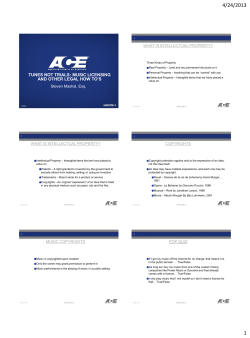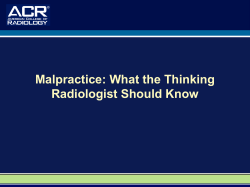
Medical Malpractice and Licensure Sheldon F. Kurtz
Medical Malpractice and Licensure Sheldon F. Kurtz The Nature and Extent of Medical Error How rampant is medical error? • • • The Harvard Study (180,000 per year) The 1999 Institute of Medicine Study (100,000 per year) Three jumbo jets going down every 2 days Does the data make your nervous about your doctor? Is there too much medical litigation? Does the data suggest reasons for physicians to be frustrated over malpractice litigation? • • Harvard found too many of the wrong persons recover Persons with most severe injury undercompensates Saks Study A negligent doctor who causes injury has a probability of sued sued of 3 out of 100. A non-negligent doctor has a probability of being sued for a nonnegligent injury of 13 out of 10,000. Thus, for every malpractice claim in response to a negligent injury there are 15-30 malpractice victims who bring no suit but there are 4-5 claims brought by non-negligently injured patients. How the Law Effects Quality of Care Medical malpractice Licensure Certification The Donabedian Model To Access Quality Care Structure • Focus on underlying capacity to deliver care (licensure, brick and mortar) Process • Studies process through which care delivered (focus on procedure by which health care delivered) Outcome • Did patient get better when patient should have gotten better Malpractice begins with outcome but largely looks to Process to find negligence Elements of a Medical Malpractice Case The Applicable Standard of Care • Ordinary and Prudent Physician would have • • • done under the same or similar circumstances Breach of the standard of care Injury and Proximate Cause between the breach and the injury McCourt v. Abernathy What are the facts of this case? • • • • • • Failure to properly diagnosis septicemia Failure to timely order diagnostic tests Failure to realize seriousness of deteriorating condition Failure to timely seek appropriate consultation Patient died Expert testified that defendant’s conduct was below the standard of care What does the court hold? • Charge (on page 316) was correct Locke v. Pachtman What are the facts of this case? • Broken needle case Why is expert testimony necessary? • Ordinary juror not equipped by common knowledge or experience to judge skill and competence of a medical service Fact that defendant’s statement may have suggested defendant erred not controlling because statement not related to the standard of care • How does court distinguish the Orozco case on page 321 • Jury’s common knowledge satisfies requirement of breach by doctors who states he cut in the wrong place. • Doctor’s statement about needle not of same effect • Some contrary authority, see note 2, page 326 Liability of resident vs. attending physician Negligent supervision The Custom-Based Standard of Care What is the medical custom standard and how does it differ from ordinary negligence law? Why does the law defer more strongly to professional standards here than elsewhere? Is the custom standard meaningful or coherent? Summary of Notes—Page 326332 Error in judgment rule Standard of care for residents, specialists and consulting and supervising physicians Availability of punitive damages Variations in the verbal formulation • • • Ordinary careful and prudent physician Reasonably prudent, minimally competent physician Good medical care Absence of data to support conclusion of what average or prudent physician would do Variations in the Standard of Care—Jones v. Chidester Two schools of thought • What constitutes a school? • A “considerable number” • Respected, reputable and reasonable What factors affect variation in practice? Locality vs National Rule-Chapel v. Allison What is the locality rule (page 337, 1st paragraph) National standard Why have courts abandoned the locality standard—at least for specialists? Should a specialist in Iowa City and Dubuque be held to the same standard? • Economic constraints What is the practical effect of one standard over another? Economic Malpractice—Page 349 Does the standard of care fall for municipal hospitals? Does the standard of care allow for different approaches to the practice of medicine based on paying status? How does the standard of care fit in with the need for research and experimentation? • Does it penalize the innovator or researcher? • Relationship to informed consent law? How does the standard of care react to specialization? Is the standard affected by cost-cutting mechanisms of HMOs Locke v. Pachtman-A Reprise Plaintiff’s attempt to use res ipsa fails To succeed, plaintiff must establish that • • • • The event was of a kind that ordinarily would not have occurred absent negligence The injury must have been caused by an agency with the defendant’s exclusive control Injury must not have been due to voluntary act or contribution of plaintiff and Evidence of the true explanation of event must be more readily accessible to defendant than to plaintiff. Notes 371-374-Avoiding Experts Common knowledge • Jury makes finding based on its own experience and knowledge- Some expert testimony required but jury can fill in gaps from its common knowledge Res ipsa loquitur • No expert testimony required Negligence per se • Can actually result in a directed verdict All of these shift focus from “prudent physician” to what jury thinks is reasonable. Notes 371-374-Avoiding Experts Res ipsa and multiple defendants • Where there were multiple defendants who were all present in operating room when injury occurred, court shifts burden to defendants to come forward with evidence as to who or who was not responsible Notes 371-374-Avoiding Experts Legal effect: • Res ipsa case still goes to jury for ultimate • • decision Court must instruct jury to find liability against at least one defendant Creates rebuttable presumption or shifts burden to defendant Helling v. Carey What are the facts of this case Given that the medical experts agree defendant complied with the standard of care, how can the plaintiff prevail? What is the potential effect of the holding on the practice of medicine? Sullivan v. O’Connor What are the facts of this case? Why are courts skeptical about contract claims? What evidentiary benefits flow to a patient claiming a breach of contract? How does a contract claim impact on the measure of damages? How might the contract approach impact on HMOs? Franklin v. Gupta What are the facts of this case? Was the surgeon personally negligent? What theories are there to hold surgeon liable for the negligent acts of others? • “Captain of the ship doctrine” • Borrowed servant doctrine (also excuses • hospital and shifts liability to surgeon) Professional corporations Strict Liability Should there be strict liability in medicine? Institutional Liability Recall structure of hospital and its relationship to its medical staff If doctors are uniformly insured, why is there such a desire to sue hospitals? Schloendorff v. Society of New York Hospital What are the facts of this case? What defenses are offered by the hospital? • • • • Charitable immunity doctrine Hospital not responsible for acts of physicians who are not employees of the hospital Nurse is agent of doctor not hospitals as her services are for docs. Even if nurse was agent of hospital, she acted reasonably • Nurses don’t question doctors Adamski v. Tacoma General Hospital What are the fact of this case? Accepting that the doctor was an independent contractor, what theories does the court suggest for holding the hospital liable? • • • Nondelegable duty rule Inherent functions doctrine Ostensible or apparent agency Do these theories apply to office-based doctors such as surgeons, internists, etc. Darling v. Charleston Community Memorial Hospital What are the facts of this case? What did the court hold? How does Johnson fit? Johnson v. Misericordia Community Hospital What are the facts of the case? Negligent selection vs. Negligent supervision Summary of Notes, Pgs. 497-505 Direct vs. vicarious liability results in holding that hospital had a duty of care to its patients independent of the duty owed to patients through members of its medical staff. Direct liability unlike vicarious liability does not require a showing that independent-contractor doctor had either actual or apparent authority Summary of Notes, Pgs. 497-505 With direct liability comes a new rationale for hospitals to assert more control over their medical staffs Summary of Notes, Pgs. 497-505 Darling and its progeny identify two types of negligence with respect to which hospital can be held liable for acts of independentcontractor physicians: • • Negligent selection • See Johnson case Negligent retention • Assumes contemporaneous supervision of daily treatment decisions as they are made Hospital risk management programs are an offshoot of this liability Boyd v. Albert Einstein Medical Center What are the facts of this case? What does the court hold? Facts to establish ostensible agency • • • • • Patient paid fees to HMO not doctor Patient selected doctors from list provided by HMO HMO screened the primary care providers HMO providers required to comply with list of rules in HMO contract HMO primary doctors had a gatekeeping function Wickline v. State What are the facts of this case? While the court ultimately concluded that the managed care organization did not corrupt the medical judgment, what is the important message of Wickline? Summary of Notes, Pgs. 517-523 The particular components of a MCO may affect how courts look at them in determining whether to impose liability. • Vicarious liability • Direct liability In some states HMOs are immune from liability by statute In Wilson v. Blue Cross of Southern California finding insurer could be liable stated “civil liability for a discharge decision rests solely within the responsibility of a treating physician in all contexts is dicta.” Enterprise Liability Dukes v. US Healthcare, Inc. What are the facts of this case? What is ERISA? What is the significance of preemption? What issue underlies the question of whether this case can appropriately be removed to a federal court? What is the issue in this case? Professional Licensure Professional Licensing What function does licensing serves? • Status • Market exclusion • State sanctioned monopolies • Quality control • Protection of public health • Increase cost of entry Physician Licensure MD DO Board Certification, not required Distinguish from credentialing State v. Miller What are the facts of this case? • Charged with practicing medicine without a • • • license Defendant claims he never held himself out as a doctor He did, however, let customers believe he could diagnose and cure ailments Routinely prescribed and furnished medicines Unlicensed Practice of Medicine Criminal Defining Medical Practice If you tell me you have a headache and I tell you to take 2 aspirins, am I engaged in the unauthorized practice of medicine? Iowa Code 148.1 For the purpose of this subtitle the following classes of persons shall be deemed to be engaged in the practice of medicine and surgery: 1. Persons who publicly profess to be physicians or surgeons or who publicly profess to assume the duties incident to the practice of medicine or surgery. 2. Persons who prescribe, or prescribe and furnish medicine for human ailments or treat the same by surgery. 3. Persons who act as representatives of any person in doing any of the things mentioned in this section. Unlicensed Practice of Medicine Is their a constitutional right to provide care? Are patient’s constitutionally permitted to obtain medical care from anyone, even non-licensed persons? Other Health Care Professionals Midwifery Nurses Physician Assistants Telemedicine Modi v. West Virginia Board of Medicine What are the facts of this case? What issues are raised by the doctor in this appeal of the Board’s action? What does the court hold? Problem, Page 954
© Copyright 2024











